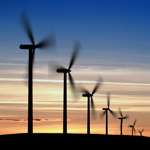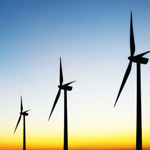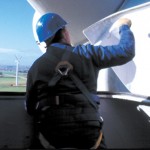 So much wind energy is now being generated in the US that the emissions-free electricity-generating technology may seriously erode the nation’s nuclear power and coal sectors, the Bloomberg news agency reported Monday.
So much wind energy is now being generated in the US that the emissions-free electricity-generating technology may seriously erode the nation’s nuclear power and coal sectors, the Bloomberg news agency reported Monday.
Headlined “nuclear industry withers in US as wind pummels prices,” the story interviewed utility experts talking about the state of the American energy sector after the nation’s wind power industry grew by about $25 billion last year.
The story noted that a significant part of that growth occurred as wind-related companies made sure they would qualify for the Production Tax Credit (PTC), the industry’s main tax incentive, which was due to expire at end of 2012. The PTC has since been extended.
“The surge added a record 13,124 megawatts of wind turbines to the nation’s power grid, up 28% from 2011,” the story said. “The new wind farms increased financial pressure on traditional generators such as Dominion Resources Inc. and Exelon Corp. in their operating regions. That’s because wind energy undercut power prices already driven to 10-year-lows by an abundance of natural gas.”
continue reading »
 Anti-wind power lobbyists have long contested claims by the wind industry that wind power is competitive with fossil fuels. But technological advances, making wind turbines bigger, smarter, and more competitive in all situations, mean the wind is fast being taken out of the naysayers’ sails.
Anti-wind power lobbyists have long contested claims by the wind industry that wind power is competitive with fossil fuels. But technological advances, making wind turbines bigger, smarter, and more competitive in all situations, mean the wind is fast being taken out of the naysayers’ sails.
Both EWEA and GWEC, the Global Wind Energy Council, agree that “onshore wind power is competitive once all the costs that affect traditional energy sources – like fuel and CO2 costs, and the effects on environment and health – are factored in”. Taking CO2 costs alone, “if a cost of €30 per tonne of CO2 emitted was applied to power produced, onshore wind energy would be the cheapest source of new power generation in Europe,” states EWEA. Moreover, wind is already “directly competitive with conventional sources in many places around the world, such as Mexico, Brazil, New Zealand, parts of China and the US,” according to GWEC.
Australia also seems to have been added to this list after a report published by Bloomberg New Energy Finance (BNEF) in February stated that wind is now cheaper than fossil fuels in producing electricity in Australia, a story reported on this blog at the time. continue reading »
 The Australian wind farm sector got a boost of confidence from a Bloomberg New Energy Finance (BNEF) analysis that showed electricity produced by the emissions-free generating technology is 14% cheaper than a new coal plant and 18% cheaper than a new gas plant.
The Australian wind farm sector got a boost of confidence from a Bloomberg New Energy Finance (BNEF) analysis that showed electricity produced by the emissions-free generating technology is 14% cheaper than a new coal plant and 18% cheaper than a new gas plant.
“The perception that fossil fuels are cheap and renewables are expensive is now out of date,” Michael Liebreich, chief executive of BNEF, said in a press release. “The fact that wind power is now cheaper than coal and gas in a country with some of the world’s best fossil fuel resources shows that clean energy is a game changer which promises to turn the economics of power systems on its head.”
The BNEF analysis showed electricity can be supplied from a new Australian wind farm for €61/MWh compared to €109/MWh from a new coal plant or €89/MWh from a new gas plant. continue reading »

Anni Podimata, VP of European Parliament
Wind will be at the centre of Europe’s power needs, meeting 50% of electricity demand by 2050, Robert Clover from MAKE Consulting said today. Moreover, “after 2020 wind is the cheapest technology, it is scaleable and it has minimal water requirements,” he added.
Speaking at EWEA’s 2013 Annual Event in Vienna, Clover said onshore wind will achieve parity with other electricity-generating technologies feeding into the grid in Europe by 2015, followed by offshore in 2022/2023.
Clover’s opinion was backed by several high-level speakers at EWEA 2013 including Fatih Birol, Chief Economist at the International Energy Agency, who said that almost all onshore wind projects in Europe will be fully competitive with gas very soon.
Clover added another element to the cost of energy debate by saying that if carbon capture and storage (CCS) technology is added to thermal generation, then costs could rise by up to another 50%.
continue reading »
 Wind energy is expanding across Europe – currently the continent has over 100 GW of wind energy capacity with levels set to rise as the EU continues on its path to a 20% share of renewable energy by 2020, but the expansion in the number of skilled workers the sector requires is not keeping up.
Wind energy is expanding across Europe – currently the continent has over 100 GW of wind energy capacity with levels set to rise as the EU continues on its path to a 20% share of renewable energy by 2020, but the expansion in the number of skilled workers the sector requires is not keeping up.
TPWind – wind energy’s research and development platform – is set to release new statistics at the European Wind Energy Association’s 2013 Annual Event in Vienna early February revealing just how deep the skills shortage runs today, and is likely to run in the future.
Engineers are in short supply, especially in operations and maintenance, the statistics will show.
continue reading »
 So much wind energy is now being generated in the US that the emissions-free electricity-generating technology may seriously erode the nation’s nuclear power and coal sectors, the Bloomberg news agency reported Monday.
So much wind energy is now being generated in the US that the emissions-free electricity-generating technology may seriously erode the nation’s nuclear power and coal sectors, the Bloomberg news agency reported Monday.









